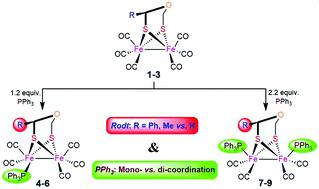当前位置:
X-MOL 学术
›
New J. Chem.
›
论文详情
Our official English website, www.x-mol.net, welcomes your
feedback! (Note: you will need to create a separate account there.)
Phosphine-substituted diiron complexes Fe2(μ-Rodt)(CO)6−n(PPh3)n (R = Ph, Me, H and n = 1, 2) featuring desymmetrized oxadithiolate bridges: structures, protonation, and electrocatalysis
New Journal of Chemistry ( IF 2.7 ) Pub Date : 2021-08-25 , DOI: 10.1039/d1nj03398k Xiao-Li Gu 1 , Jian-Rong Li 1 , Bo Jin 1 , Yang Guo 1 , Xing-Bin Jing 1 , Pei-Hua Zhao 1
New Journal of Chemistry ( IF 2.7 ) Pub Date : 2021-08-25 , DOI: 10.1039/d1nj03398k Xiao-Li Gu 1 , Jian-Rong Li 1 , Bo Jin 1 , Yang Guo 1 , Xing-Bin Jing 1 , Pei-Hua Zhao 1
Affiliation

|
Two new series of phosphine-substituted diiron complexes Fe2(μ-Rodt)(CO)6−n(PPh3)n (n = 1 for 4–6 and n = 2 for 7–9) bearing desymmetrized oxadithiolate bridges (i.e., Rodt bridges), which can be considered as diiron subsite models of [FeFe]-hydrogenases, were prepared through the Me3NO-induced replacements of all-CO diiron precursors Fe2(μ-Rodt)(CO)6 (Rodt = SCH(R)OCH2S; R = Ph (1), Me (2), and H (3)) with one equivalent or excess PPh3. All the as-obtained complexes have been fully characterized by elemental analysis, various spectroscopy methods, and especially for 4, 7–9 by X-ray crystallography. Further protonation and electrochemistry of 4–6 and 7–9 with Rodt bridges are studied and compared without and with CF3CO2H (TFA) and CH3CO2H (HOAc) as strong and weak acidic proton sources by in situ IR plus NMR spectroscopies and cyclic voltammetry. On the one hand, under excess TFA, the monosubstituted complexes 4–6 are partially protonated to produce a mixture of main precursors 4–6 and minor Fe-protonated species [4(μH)]+, [5(μH)]+, and [6(μH)]+, whereas the disubstituted counterparts 7–9 are completely protonated to form an isomeric mixture of their hydride species [7(μH)]+, [8(μH)]+, and [9(μH)]+ in transoid-dibasal and apical-basal fashions. On the other hand, complexes 7–9 show better electrocatalytic proton reduction activities (i.e., higher turnover numbers/TONs) under TFA or HOAc relative to counterparts 4–6, in which the TONs of 4, 5 and 7, 8 with Phodt or Meodt bridges are a little higher than those of 6 and 9 with odt bridges, respectively. These findings reveal that the redox and electrocatalytic behaviors of 4–6 and 7–9 with Rodt bridges are affected not only by phosphine coordination modes (PPh3, mono- vs. di-substitution) but also by desymmetrized dithiolate bridges (Rodt, R = Ph, Me vs. H).
中文翻译:

膦取代的二铁配合物 Fe2(μ-Rodt)(CO)6−n(PPh3)n (R = Ph, Me, H and n = 1, 2)
两个新系列的膦取代的二铁配合物 Fe 2 ( μ -Rodt)(CO) 6− n (PPh 3 ) n ( n = 1 for 4-6 and n = 2 for 7-9 ) 带有去对称的二硫醇桥(即, Rodt 桥),可以被认为是 [FeFe]-氢化酶的二铁亚位点模型,是通过 Me 3 NO 诱导的全 CO 二铁前体 Fe 2 ( μ -Rodt)(CO) 6 (Rodt = SCH(R)OCH 2 S;R = Ph ( 1 ), Me ( 2) 和 H ( 3 )) 与一个当量或过量的 PPh 3。所有获得的配合物都已通过元素分析、各种光谱方法,特别是4 , 7-9的 X 射线晶体学进行了充分表征。研究了具有 Rodt 桥的4-6和7-9 的进一步质子化和电化学,并通过原位IR 将CF 3 CO 2 H (TFA) 和 CH 3 CO 2 H (HOAc) 作为强酸性和弱酸性质子源进行了比较加上核磁共振光谱和循环伏安法。一方面,在过量的 TFA 下,单取代的复合物4-6部分质子化以产生主要前体4–6和次要 Fe 质子化物种[4( μ H)] +、[5( μ H)] +和[6( μ H)] +的混合物,而双取代的对应物7–9完全质子化以形成它们的氢化物[7( μ H)] +、[8( μ H)] +和[9( μ H)] +的异构混合物,位于transoid -dibasal 和 apical-基础时尚。另一方面,复合体7-9显示出更好的电催化质子还原活性(即TFA或HOAc中相对于对应下,较高的转换数/吨)4-6,其中的吨4,5和7,8与Phodt或Meodt桥是高一点比分别带有 odt 桥的6和9 的那些。这些发现表明,具有 Rodt 桥的4-6和7-9的氧化还原和电催化行为不仅受膦配位模式(PPh 3,单-与磷)的影响。双取代),但也可以通过去对称的二硫醇桥(Rodt,R = Ph,Me vs. H)。
更新日期:2021-09-13
中文翻译:

膦取代的二铁配合物 Fe2(μ-Rodt)(CO)6−n(PPh3)n (R = Ph, Me, H and n = 1, 2)
两个新系列的膦取代的二铁配合物 Fe 2 ( μ -Rodt)(CO) 6− n (PPh 3 ) n ( n = 1 for 4-6 and n = 2 for 7-9 ) 带有去对称的二硫醇桥(即, Rodt 桥),可以被认为是 [FeFe]-氢化酶的二铁亚位点模型,是通过 Me 3 NO 诱导的全 CO 二铁前体 Fe 2 ( μ -Rodt)(CO) 6 (Rodt = SCH(R)OCH 2 S;R = Ph ( 1 ), Me ( 2) 和 H ( 3 )) 与一个当量或过量的 PPh 3。所有获得的配合物都已通过元素分析、各种光谱方法,特别是4 , 7-9的 X 射线晶体学进行了充分表征。研究了具有 Rodt 桥的4-6和7-9 的进一步质子化和电化学,并通过原位IR 将CF 3 CO 2 H (TFA) 和 CH 3 CO 2 H (HOAc) 作为强酸性和弱酸性质子源进行了比较加上核磁共振光谱和循环伏安法。一方面,在过量的 TFA 下,单取代的复合物4-6部分质子化以产生主要前体4–6和次要 Fe 质子化物种[4( μ H)] +、[5( μ H)] +和[6( μ H)] +的混合物,而双取代的对应物7–9完全质子化以形成它们的氢化物[7( μ H)] +、[8( μ H)] +和[9( μ H)] +的异构混合物,位于transoid -dibasal 和 apical-基础时尚。另一方面,复合体7-9显示出更好的电催化质子还原活性(即TFA或HOAc中相对于对应下,较高的转换数/吨)4-6,其中的吨4,5和7,8与Phodt或Meodt桥是高一点比分别带有 odt 桥的6和9 的那些。这些发现表明,具有 Rodt 桥的4-6和7-9的氧化还原和电催化行为不仅受膦配位模式(PPh 3,单-与磷)的影响。双取代),但也可以通过去对称的二硫醇桥(Rodt,R = Ph,Me vs. H)。











































 京公网安备 11010802027423号
京公网安备 11010802027423号